
Viral Stories: How to Use Surveys to Create Buzzworthy Content
In today’s fast-moving digital world, viral stories are more than just lucky breaks they are strategic opportunities. These stories capture attention, spark emotion, and are widely shared across the web. Whether you’re a brand, a media outlet, or a content creator, going viral can dramatically increase your reach and credibility.
But here’s the good news: you don’t have to wait for inspiration or hope your post takes off. Instead, you can build viral stories intentionally and one of the most effective ways to do that is by using surveys.
Surveys unlock unique, original insights that resonate with your audience. With platforms like Polling.com, you can create data-driven narratives that not only engage but also deliver measurable results. Let’s explore how surveys can fuel buzzworthy content.
Why Viral Stories Matter in the Digital Age
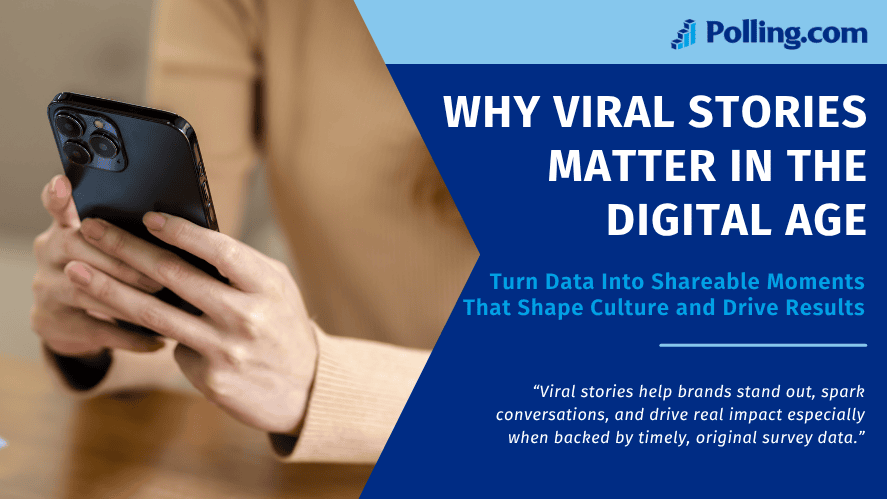
Have you ever wondered why some content spreads like wildfire while other pieces barely get noticed?
A viral story connects on an emotional level, is easy to understand, and feels timely. Additionally, it gives people something they feel compelled to share. For businesses, the impact is huge. Viral content can lead to:
- Increased brand visibility
- Higher engagement on social platforms
- More inbound links and media mentions
- Stronger emotional connections with your audience
Therefore, the return on investment (ROI) from viral stories is undeniable. More importantly, when these stories are based on credible data such as that from a market survey they’re even more impactful.
Platforms like Polling.com make this process seamless. You can collect real-time data, analyze trends, and build narratives that spark real-world conversations.
Section 1: Anatomy of a Viral Story
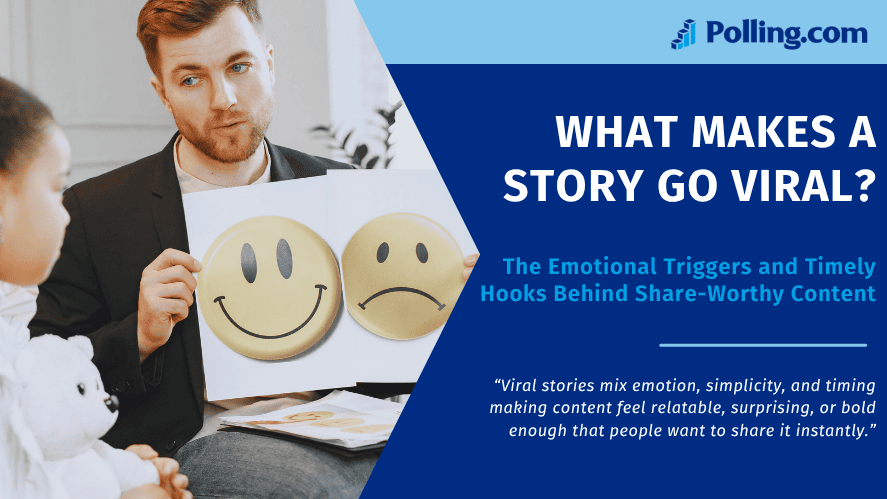
Although no formula guarantees virality, several elements consistently appear in top-performing content:
- Emotional triggers: Content that elicits awe, laughter, anger, or surprise tends to perform well.
- Relatability and identity: People are more likely to share content that resonates with their values or mirrors their personal identity.
- Brevity and clarity: Complex topics should be simplified without losing their message.
- Relevance and timing: Stories aligned with current events or trends are far more likely to spread.
Consequently, when crafting your story, you should think about what your audience feels not just what they think.
Types of Viral Stories Built From Survey Data
Survey results can be used to shape several high-performing content formats, such as:
- Public opinion snapshots: For example, “58% of Gen Z think college isn’t worth it.”
- Surprising facts: Data that challenges common beliefs or stereotypes.
- Divisive vs. unifying narratives: You can choose to spotlight issues that split or unite opinions.
- Lighthearted insights: For instance, fun surveys like “Which ice cream flavor best matches your personality?” often gain traction simply because they’re entertaining.
In turn, each of these formats leverages survey data in a way that makes the content more compelling and more likely to be shared.
Section 2: The Strategic Power of Surveys in Content Creation
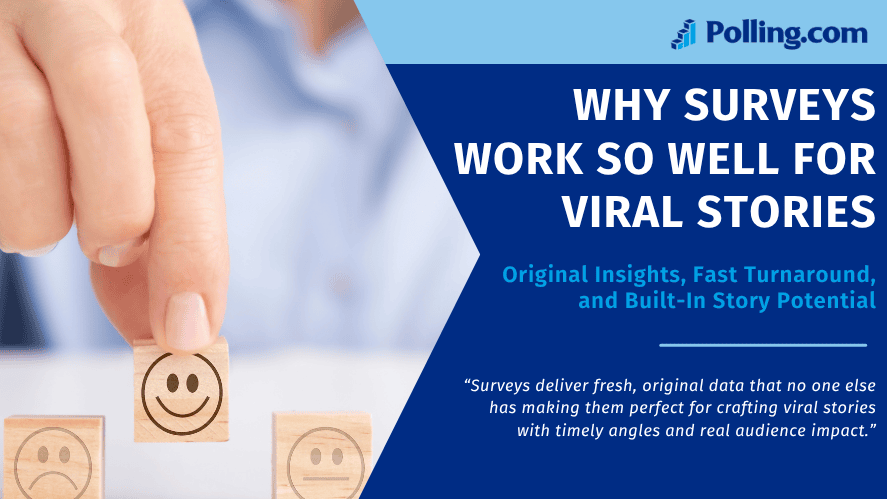
Unlike recycled content or opinions, surveys provide original information that adds value. Here’s why they’re ideal:
- Exclusive insights: You own the story because you created the data.
- Speed and scale: With tools like Polling.com, you can launch surveys and get results quickly.
- Multi-channel versatility: Survey findings work well across blogs, videos, press releases, newsletters, and any social media post.
As a result, you’re able to feed your content funnel with insights that no competitor has.
Real-Life Examples of Survey-Based Viral Content
Many well-known viral stories have been rooted in simple survey insights. Here are a few examples:
- A political survey revealed unexpected shifts in voter sentiment, earning national media attention.
- A consumer habits poll conducted by a skincare brand guided their product launch messaging and that campaign gained coverage from beauty influencers and industry blogs.
- A fun survey asking pet owners about their pets’ personalities exploded on TikTok and Instagram because it was both funny and personal.
Each of these examples started with a well-designed market research survey and ended with wide exposure and engagement.
Section 3: Designing Surveys That Can Go Viral
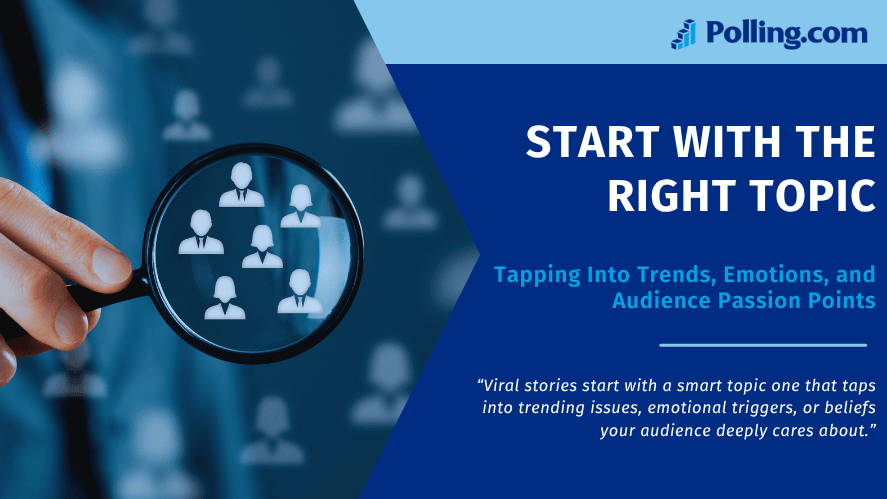
The key to buzzworthy storytelling is starting with a topic that already has energy behind it. You can achieve this by:
- Monitoring news cycles and trending conversations
- Picking themes that trigger strong emotions or opinions
- Aligning with your audience’s beliefs and values
In many cases, content ideas generated from listening to your community lead to the most powerful viral surveys.
Writing Questions That Spark Stories
The effectiveness of your survey largely relies on the way your questions are framed. Here’s how to optimize:
- Use a mix of open and closed formats. Open-ended questions can yield great quotes, while closed-ended provide stats for charts.
- Focus on types of questions that invite curiosity or emotion.
- Avoid jargon and keep it simple clarity leads to better answers.
Understanding the types of survey questions that work best for storytelling helps you maximize the data’s value.
Targeting the Right Audience for Impact
To make your data meaningful, it needs to reflect the voice of the right people. With Polling.com, you can:
- Target specific demographics like age, location, or industry
- Create sub-groups to compare responses
- Reach niche audiences that are often ignored
Tailored targeting ensures that your survey data is both accurate and relevant the foundation of a viral-ready story.
Section 4: Turning Survey Data Into Stories That Spread
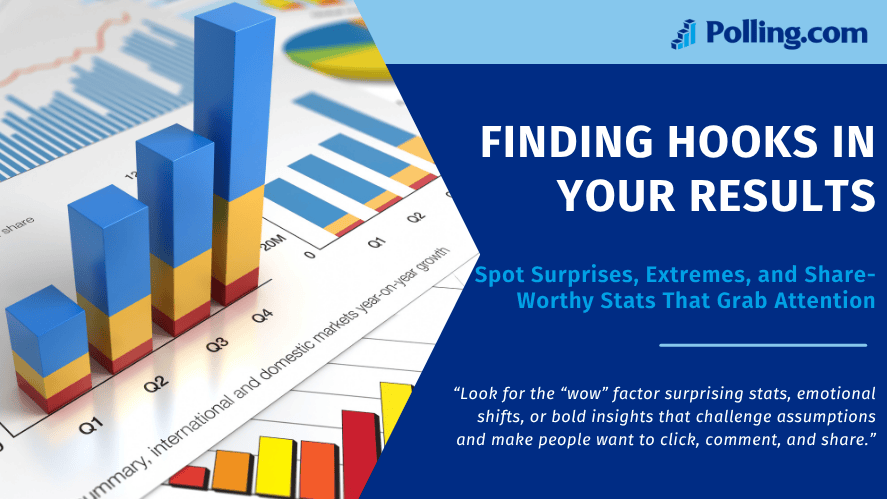
Once your survey responses are in, focus on uncovering the most impactful insights. Look for:
- Shocking or unexpected statistics
- Contradictions between groups
- Notable shifts compared to previous data or norms
These “aha” moments are perfect for headlines, tweet threads, and survey analysis reports.
Framing the Story for Maximum Appeal
Once you know the angle, build the story around it. Try this approach:
- Show contrast or conflict by highlighting an unexpected result
- Tie findings to larger societal discussions or trends
- Add quotes from respondents to give the data a personal touch
For instance, use qualitative research survey questions to gather narratives that complement your stats.
Visual Content Makes a Difference
People are far more likely to share content that looks good. So, convert your findings into:
- Infographics and short-form videos
- Slides or carousels for LinkedIn and Instagram
- Branded visuals using Polling.com export tools
The easier your insights are to consume, the more likely they’ll be shared.
Section 5: Case Studies – Viral Stories Created Using Polling.com
National Political Insights
A civic nonprofit used Polling.com to survey 5,000 voters. Consequently, the findings highlighted generational differences in political priorities and quickly gained traction among journalists and Twitter influencers.
Skincare Launch Campaign
A beauty brand polled 1,200 women on their skincare routines. Their findings not only informed product messaging but also earned media coverage and influencer shoutouts.
Interactive Lifestyle Trend
A food company launched a fun survey asking users to match their breakfast habits to personality types. As a result, it became a trending TikTok challenge within 72 hours, thanks to strong social media engagement ideas.
Section 6: Sharing Your Story Across Channels
Blog Posts and Reports
Use survey results to write:
- Deep-dive blog posts
- Shareable survey analysis reports
- Downloadable PDFs with charts and summaries
Social Media
Repurpose your data into:
- Interactive polls
- Carousels or reels
- Memes or short facts with emojis
High-performing social media posts often feature one strong visual paired with one surprising stat.
PR and Media Outreach
Make your content media-ready by:
- Writing headlines journalists can use
- Including compelling pull quotes
- Providing downloadable graphics
This helps your content get picked up more easily.
Email Campaigns and Newsletters
Use your email list to amplify results by:
- Segmenting by interest or behavior
- Sharing personalized insights
- Linking back to full results for added traffic
Section 7: Promotion Strategy for Maximum Reach
Organic Tactics
- Share results with your community
- Ask team members or influencers to repost
- Use UGC to further engagement
Paid Distribution
- Boost posts with strong performance
- Run popular surveys as lead magnets
- Use native ads on relevant platforms
Launch Timing
Plan strategically to align with:
- Industry events or awareness months
- Holidays or seasonal shifts
- Product or campaign launches
Additionally, use teaser campaigns to build anticipation and maximize your reach on launch day.
Section 8: Avoid These Common Pitfalls
To ensure your story remains effective, avoid making these common mistakes:
- Overloading with stats and no narrative
- Biased or unclear questions
- Poor visual formatting
- Sharing content on only one channel
Ultimately, a strong strategy and content plan should guide both your survey and your distribution.
Section 9: Why Polling.com Is Built for Viral Survey Content
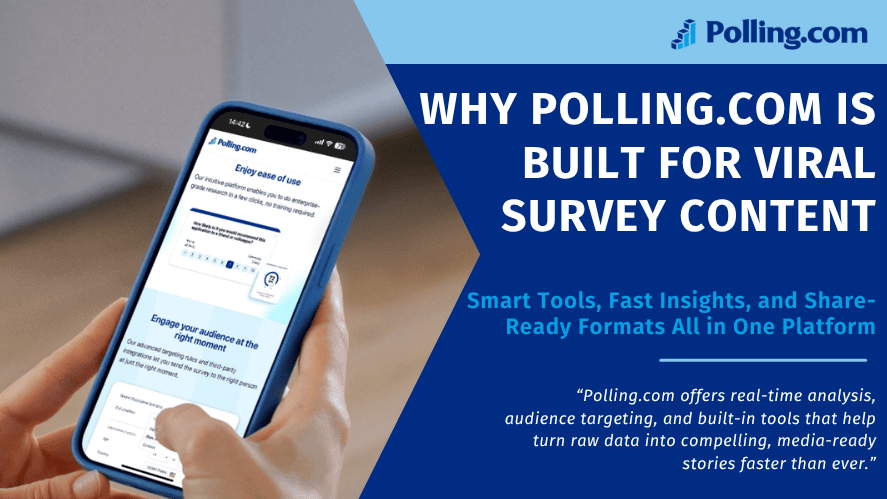
Unlike basic form tools, Polling.com offers:
- Rapid setup and real-time dashboards
- Advanced targeting and filtering
- Survey templates built for media and marketing
- One-click exports for infographics and visual assets
If you’re aiming to create viral stories backed by credible data, Polling.com simplifies the entire process from idea to amplification.
Frequently Asked Questions (FAQs)
Keep it concise. Between 5 and 10 well-crafted types of survey questions is ideal for completion and quality.
Absolutely. Fun surveys engage audiences and can reveal meaningful insights when analyzed correctly.
Use emotional hooks, engaging visuals, and surprising results. These make your story more compelling and viral-ready.
Yes. These questions often yield quotes and personal stories that add depth to your data.
Ask yourself: Is it engaging, visually appealing, and based on original insights? If so, you’re on the right track.
Conclusion: Ready to Build Your Viral Story?
The power of viral stories lies in blending emotional resonance with credible insights. With surveys, you can tap into what people really think and with Polling.com, you can do it faster, smarter, and more creatively than ever before.
Start with a good question. Let the data lead the narrative. Then, share your story with the world.
Launch your next viral survey today at Polling.com.
